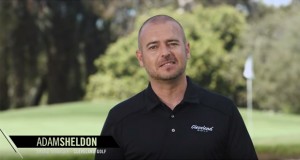 Geoff Mangum is a leading putting instructor and founder of www.PuttingZone.com, which has received more than 1.8 million visits since its inception (Geoff’s site predates PutterZone.com, and any similarities in domain name are coincidental). Geoff’s techniques combine modern neuroscience with his best findings from putting lore and history. According to Geoff’s official bio: “Mangum’s first PGA Tour student took a single lesson and his putting improved from 160th on tour to 16th in the field two months later at the 2003 PGA Championship, where he won his first tour victory and a major, nearly tripling his income. Working from Greensboro, North Carolina, Mangum teaches throughout the United States and Europe and is currently expanding into Canada, South Africa, Asia, Australia and New Zealand. He is also a ‘teacher’s teacher’ who has taught many of the top instructors in the world.” Geoff was kind enough to elaborate on his research and teachings in the following exclusive interview:
Geoff Mangum is a leading putting instructor and founder of www.PuttingZone.com, which has received more than 1.8 million visits since its inception (Geoff’s site predates PutterZone.com, and any similarities in domain name are coincidental). Geoff’s techniques combine modern neuroscience with his best findings from putting lore and history. According to Geoff’s official bio: “Mangum’s first PGA Tour student took a single lesson and his putting improved from 160th on tour to 16th in the field two months later at the 2003 PGA Championship, where he won his first tour victory and a major, nearly tripling his income. Working from Greensboro, North Carolina, Mangum teaches throughout the United States and Europe and is currently expanding into Canada, South Africa, Asia, Australia and New Zealand. He is also a ‘teacher’s teacher’ who has taught many of the top instructors in the world.” Geoff was kind enough to elaborate on his research and teachings in the following exclusive interview:
You state that “The PuttingZone represents a unique and revolutionary approach to the art of golf’s game within a game based on the science of brain functioning.” Can you elaborate on this approach and how it benefits the average golfer?
What I teach is an integrated constellation of putting skills that respect and enhance innate human brain processes for perception and movement. I call this “The Mechanics of Instinct”, because the end result of my teaching is to make putting instinctive rather than a matter of problem-solving and rules-application. I do this by training and coaching golfers to respect and enhance the natural processes shared by all human brains in targeting—reading putts and aiming the putter—and in stroke movement.
This approach allows even the best putters in professional tour golf to improve putting skills across the board in order to leave streakiness behind and get on track with steady upward improvement. But it also is readily teachable to amateur or even beginner golfers. That’s because all normal adult humans have brains that are designed by eons of evolutionary adaptation for successful movement on earth in gravity, and unleashing this capacity on the putting green is less a matter of complex golf instruction and “rules” of technique and more a matter of getting past golfing “rules” back down to simple human movement skills like balance, form, and timing. Putting at the highest level of skill is very simple, even minimalist, but that doesn’t mean a normal adult amateur golfer cannot perform at this level with appropriate coaching.
You set out to learn everything about putting, historical and otherwise, acquiring more than 11,000 records in the process. What was the most surprising or noteworthy discovery to come out of your research?
The most surprising thing I’ve learned from surveying the whole of golf instruction for putting from the very beginning, around 1880, to today is that golf instructors have seriously addressed the issues of how to putt in only one of the four required skills for putting, so three-fourths of putting instruction is very largely terra incognito, or unknown territory.
Every golfer who putts tries his hand at four separate skills : he reads the putt to select a path or target near the hole; he aims the putter and his body in the setup for the forthcoming stroke; he putts straight as intended; and he controls the pace or distance of the roll effectively. Of these four fundamental putting skills—reading, aiming, stroking, and controlling distance—historical golf instruction only seriously engages the stroke, and even that body of lore changes over the decades with changes in equipment and course conditions, and in modern times is beset by considerable confusion in the very basics of putting stroke biomechanics and physics. But the other skills are simply not addressed in any depth.
What are your thoughts on these other skills?
(Touch): Almost all golf instructors say that “touch” cannot be taught, and the golfer is either born with touch or has to acquire it over many years of playing golf. This is incorrect in fact, as all normal adults have great putting touch innately, or they would not be able to move around the world as successfully as they do every day, opening doors and picking up glasses of water off a table. Touch is not a matter reserved for the gifted golfer, but can be unleashed in the normal adult who has never played golf before.
(Aiming): Even though 90 percent of all golfers, pros included, do not accurately aim their putter faces inside the hole from as close as ten feet more than half the time, and are not even aware that this is the case, there has not been heretofore any golf instruction that teaches the golfer the perceptual skills required for looking down at a putter face and using a physical-visual process that accurately judges where, in fact, that putter face points across the green. The many instructors using lasers to prove to the golfer that his aiming skills are deficient do not teach the golfer these perceptual skills. My teaching about the direction the eyes aim out of the face, as opposed to positioning the eyeballs directly above the ball, is a novel contribution to golf that clarifies a great deal of confusion about the way the eyes and vision work in putting aiming perceptions.
(Reading): For reading putts, I found that there is only one book ever written in the history of golf that deals in depth with the issues of how gravity and physics determine the path of a ball rolling on a contoured surface, and with the perceptions of the human for appreciating the contours of the green. Almost all instructors limit their “reading” teaching to simplistic “rules of thumb” about grain, mountains, oceans, and where to stand at different points in the reading routine. The key skills of accurately perceiving the fall-line’s orientation through the cup, using various sorts of perceptual skills in assessing the contour shape, and in accurately visualizing and predicting how slope, green speed and ball rolling speed will interact to result in a very specific path for the successful putt, really aren’t addressed in golf instruction at all.
(Stroke): With respect to the stroke movement itself, there is a long-running theme of confusion in golf about whether the stroke motion should be like a miniature golf swing or more straight-back and straight-through. The idea that “whatever works best for you” is a bogus notion that allows people to avoid investigating the matter of optimal performance. The optimal stroke has to be founded in the realities of physics and the human brain and body, and these factors have much more in common from one golfer to another than significant differences. All brain visual and balance and movement processes follow the same general patterns of organization. All adult golfers are not terribly different in stature and size, all have two arms and two eyes and two hands and two feet, all are holding similar putters, all have one ball and face the same greens, and all live and move on the same earth in the same gravity. So there are many more similarities in optimal technique, at a fundamental level, than there are idiosyncracies from golfer to golfer.
Can you please tell us more about your clinics? What they offer and how they work?
The full-day clinic is suitable for the professional player or teacher, the elite amateur, and the avid amateur. The clinic covers the four skills of putting with the “Mechanics of Instinct” in a combination of lecture, demonstration, and hands-on learning, with supporting drills and exercises. The clinics also cover putter fitting and selection, putting psychology, and how to practice for skills and how to warm up for a round. Usually, clinics are limited to between 15 and 20 participants, start out with about two hours of indoors orientation, and then spend the rest of the day outdoors on the putting green. I teach the movement skills of touch and straight putting first, so the golfer has a “gun that shoots straight where aimed the correct distance,” and only then move on to aiming at a target and reading putts in order to select the target.
At the end of the day, the golfer has an understanding of how the instincts best work on a consistent basis for picking a target based on a good visualized prediction of reality of the ball’s final path entering the hole with good delivery speed; for aiming the putter face and body accurately at this target so that only the same-every-time straight stroke movement is called for; for making the same-every-time stroke movement; and for doing so with a stable tempo and an instinctive sense of touch. He also has tools enabling him to get on a steady track of improvement and to self-coach during play to get back on track with the least wasted time and mental trouble.
Thank you, Geoff! Please visit www.PuttingZone.com for more information.
 PutterZone – Best Putter Reviews
PutterZone – Best Putter Reviews



